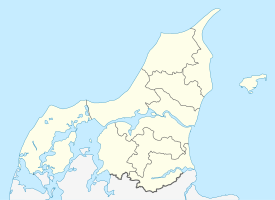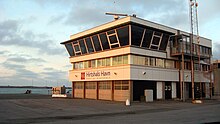Hirtshals Havn
| Hirtshals Havn | |||
|---|---|---|---|
| Data | |||
| UN / LOCODE | DK HIR | ||
| operator | Hirtshals Havn | ||
| start of building | 1919 | ||
| opening | December 1, 1929 | ||
| Port type |
Sea port fishing port ferry port industrial port marina |
||
| Total area of the port | 1,100,000 m² (2016) | ||
| Passengers | 2.4 million (2016) | ||
| website | www.hirtshalshavn.dk | ||
| Geographic information | |||
| place | Hirtshals | ||
| region | North Jylland region | ||
| Country | Denmark | ||
| Hirtshals Harbor | |||
| Coordinates | 57 ° 35 '43 " N , 9 ° 57' 59" E | ||
|
|||
The port of Hirtshals ( Danish : Hirtshals Havn ) is located between Jammer Bay and Tannis Bay . It is one of the largest fishing ports in Denmark . When the port was built from 1919 to 1930, it was the first Danish port to face the open North Sea.
The port has been operated by local authority since 2001. It has a quay length of 4.7 kilometers and an area of around 1,100,000 m², of which 310,000 m² are rented. The seven harbor basins, up to 10.5 meters deep, are spread over 465,000 m² of water. The port administration reports a turnover of 76.6 million Danish kroner for 2016 . Cargo handling reached 1.8 million tons in 2016. During the year the port moved 169,000 trucks and 735,000 cars and was used by 2.4 million passengers. Of the 2,700 jobs that the port will create in the Nordjylland region , the majority will be attributed to the core businesses of transport and fishing.
history
prehistory
When the idea of building a port on the west coast of Vendsyssel arose at the beginning of the 19th century , the focus was not initially on fishing. Rather, there was a desire to be able to deliver mail to Norway directly and without going through Sweden . Small ships that were previously used in trade between Vendsyssel and southern Norway should serve as post boats; an ice-free port was desirable for this. Prince Regent Friedrich VI. 1805 gave priority to today's Frederikshavn on the east coast of Vendsyssel.
When plans arose again in the 1880s to build a port on the west coast, great opportunities for fish export were seen. In 1883 the newspaper Vendsyssel Tidende wrote that Hirtshals could become one of the largest fishing ports in Europe due to its location. But it wasn't until 1914 that a state commission was set up and a law passed in 1917 to encourage the construction of a port in Hirtshals. Engineer Jørgen Fibiger directed the construction between 1919 and 1930.
Early years
December 1, 1929 is considered the opening date, as this was the first day that fees for landing fish were charged. In the first few years the port activities grew only slowly, mainly because England and the German Empire limited Danish fish exports with import duties and quotas. The population was all the more expectant of the ferry connection established in 1937 to Kristiansand in Norway .
During the German occupation of Denmark in World War II , fishing was faced with some handicaps. So the Germans laid out a mine belt in the North Sea and delimited the fishing areas. The lack of equipment and the rationing of oil created further problems. On the other hand, the war increased the demand for fish in Germany, which in the period from 1939 to 1941 alone led to a four-fold increase in income. When the Germans evacuated all of the Hanstholm fishing families to Hirtshals in March 1943 because the occupiers were building Hanstholm into a main fortress on the Atlantic Wall , this meant a further increase in the port of Hirtshals. The houses of 31 families were expropriated, but the compensation could be invested in new fishing trawlers.
Post-war years until the end of the 1970s
After the war, the traditional snurrevodsfiskeri , a specifically Danish type of trawling used to catch plaice in the region, disappeared . In addition, the sale of fish to England became more difficult, and in the destroyed Germany it came to a standstill. This led to the fact that the fishery was switched to, among other things, herring and porbeagle . At the same time as the increasing sales to Allied troops in Germany, the first filleting factories were established in the city.
Thanks to the herring fishery and its processing, Hirtshals developed into one of the most important fishing ports in Northern Europe. Especially from the late 1950s to the early 1970s, the fishing industry, the port and the city recorded strong growth. With newly acquired steel trawlers , between 15,000 and 25,000 tons of fish were caught annually in the 1960s. In almost the entire period from 1949 to 1977, the landings of foreign herring fishermen were greater than those of the Danish. Swedish fishermen in particular used Hirtshals as a port because it was closer to the Central European market for herring.
Until the first machines for filleting herring arrived around 1960 , the fish were still processed by hand. The machines increased production and kept prices stable. A side effect of the herring industry has been the use of waste products. About half of the herring masses that were not wasted during filleting were processed into fish meal. In addition to the two fishmeal factories founded in 1954, three more were added in the 1960s.
Together with Skagen , Hirtshals covered almost the entire European market for herring fillets in the early 1970s. But already at the end of the 1960s the consequences of overfishing became apparent, which also hit Hirtshals. Even before the herring fishery in the North Sea was temporarily stopped in 1977, the fishery was shifted to mackerel , which is why the local fishing industry had to switch its production from herring to mackerel fillet.
1980s until today
Since the late 1970s, activities in the port have declined, although for a short time high hopes were placed in the fishing for plaice. While 840 fishermen were still working in the port in 1975, their number had fallen to 390 by 2001. The size of the fishing fleet also halved during this period. Instead, the herrings returned in the 1990s. Along with mackerel, they were among the most important edible fish, of which between 80,000 and 120,000 tons were caught annually.
On the night of December 1, 1981, the RF 2 lifeboat sank off Hirtshals . A memorial in the harbor today commemorates the accident in which three fishermen and six crew members perished.
In the early 1980s, the Nordsøcentret Fisheries Research Center (now Nordsøen Forskerpark ) opened, which houses various state and private research institutions. The center examines fish stocks, develops fishing equipment and improves fish products. Part of the facility is the North Sea Oceanarium , which was opened in 1984 as the "North Sea Museum" and gives the public an insight into the fauna of the North Sea. In 1998 an aquarium was inaugurated for this purpose, which with 4.5 million liters of water is the largest of its kind in Europe.
The research center later dealt with fish farming , which became increasingly important for the local fish industry. Large quantities of salmon, especially from Norway and the Faroe Islands, are now salted, smoked and packaged in Hirtshals before they are further exported. Other types of fish, shrimp and shellfish are also brought to Hirtshals in refrigerated containers to be processed in the factories there. Around the year 2000, around 900 people were employed in the fishing industry.
Ferry port

In addition to its function as a fishing port and yacht harbor , the location also serves as an important ferry port , from which the Norwegian shipping company Color Line calls at the Norwegian cities of Kristiansand and Larvik . Fjord Line ships also operate to Stavanger , Bergen , Langesund and, in summer, also to Kristiansand. Since the beginning of October 2010, Fjord Line has shared the ferry terminal in the east port with Smyril Line , which calls at Norröna Tórshavn on the Faroe Islands and Seyðisfjörður on Iceland . Hirtshals replaced Esbjerg and Hanstholm as the transport port to the Faroe Islands, which justifies the Smyril-Line with a shorter journey time that is three hours less than the winter route via Esbjerg. On the other hand, Hirtshals is better connected to the transport network, especially compared to Hanstholm - both to the south via the Hirtshalsmotorvejen , the Danish section of the European route 39 to Aalborg , and to the north via the ferry connections to Norway. For the port director Jens Kirketerp Jensen, the decision of the Smyril Line documents the central role of the Hirtshals port as a hub for RoRo shipping in Northern Europe.
literature
- Henrik Bredmose Simonsen: Histories om Hirtshals Havn . In: Nordjyllands Amt (Ed.): Havets Nordjylland . Aalborg 2002, ISBN 87-7775-461-1 , p. 168-175 (Danish).
- Torben Vandsted (Ed.): Hirtshals Havn - et Kraftcenter i constant udvikling . 1st edition. Hirtshals Havn, Hirtshals 2005, ISBN 87-990792-1-6 (Danish).
Web links
- Hirtshals Havn Official Website
- North Sea Oceanarium
- Hirtshals Havn - Den erhvervsøkonomiske betydning Economic importance of the port (Danish)
Individual evidence
- ↑ Note: Other ports are protected e.g. B. behind an island ( Esbjerg ), in the fjord or on the canal ( Hvide Sande , Torsminde, Thyborøn ).
- ↑ Facts about the port ( English ) Hirtshals Havn. Retrieved February 18, 2018.
- ↑ Ellen Damgaard: Redningsbåden (PDF; 82 kB) in Lemvig Museum from March 2003, accessed on October 17, 2010 (Danish)
- ↑ The Store Danske : Nordsøcentret , accessed on October 17, 2010 (Danish)
- ^ Transport til & fra Hirtshals ( Danish ) In: Toppen af Danmark . Retrieved February 18, 2018.
- ^ Poul Christoffersen: Hirtshals får færge til Færøerne ( Danish ) In: Nordjyske . September 2, 2010. Retrieved February 18, 2018.



